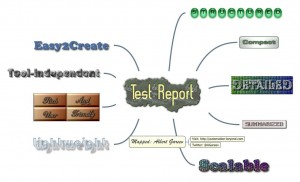Generating Test Reports (MindMap)
Whether it’s an all-round automation tool, like TestComplete, or a lightweight Session-Based Exploratory Testing assistant, like RapidReporter, generating good test reports is a challenging task. Obviously, hand-crafted reports would be much better, and live communication is an ideal. Though quite often testers have to report in writing and/or remotely. And if testing is conducted with assistance of a tool then using the tool in producing test reports (of course, in such non-sapient parts of the job as data conversion, formatting, etc.) is of great help too.
I used to write on importance of a test log, and logging, and the general requirements to the test log, as a part of Usability Requirements. Now I’m putting it as high-level ideas in writing and as a mind map.
Mapping the ideas
So, Test Reports…
They are used by fellow team members and management. They help communicating results of the work done (immediate value), but they might also be used as a source for statistics (prolonged value). What does it mean in terms of expectations and requirements?
Compact and Summarized
Everyone is busy at work. People scroll down documents even faster than they screen the text. No one is gonna spend time figuring facts from lyrics. Therefore, a test report must be summarized, as is the good news block. And news writing style is a technique we can borrow from journalists.
Scalable and Structured
For the same reason as before, a short compact test report is better than long and expansive. But if you really have much to report, organize the information in summarized blocks. Use inverted pyramid style.
Detailed
Readers and users of the reports might request as much as possible details of the specific test scenario executed. So, if your tool logged everything (and good tools do that), these details must be accessible on demand with a minimal manual effort creating them.
Rich
Tables, pictures, diagrams make text easier to follow and remember. Though hand-crafting is time-consuming, so a tool should supply pre-defined and customizable templates.
Lightweight and Portable
Different companies have different regulations on document format and storage, so reports must be lightweight and easily portable; if needed, accessible on different platforms.
Tool-independent but Easy-to-Create
With all said, sticking to a single tool (especially a commercial one) as a viewer of test reports is not a flexible approach. However, creating or adapting a viewer must not be a complex task itself.
The sample solution and a new tutorial
Those are contradictory expectations. And, probably, for a purely hand-crafted test reporting it is not possible to fulfil them. But with a hybrid approach – sapient testing and automated execution – we might be able to do something close. We will try to do it together, step by step, in a new tutorial.




One response to "Generating Test Reports (MindMap)"
Hi Albert,
I read this previously, but I must have been short on time as I’ve taken some excellent tips.
I particularly like inverted pyramid suggestion. This could actually be very useful when writing large educational styled articles.
Thanks for sharing,
Cheers,
Darren.
[ Albert’s reply. I think, large testing reports can and should be educational, too. :) ]